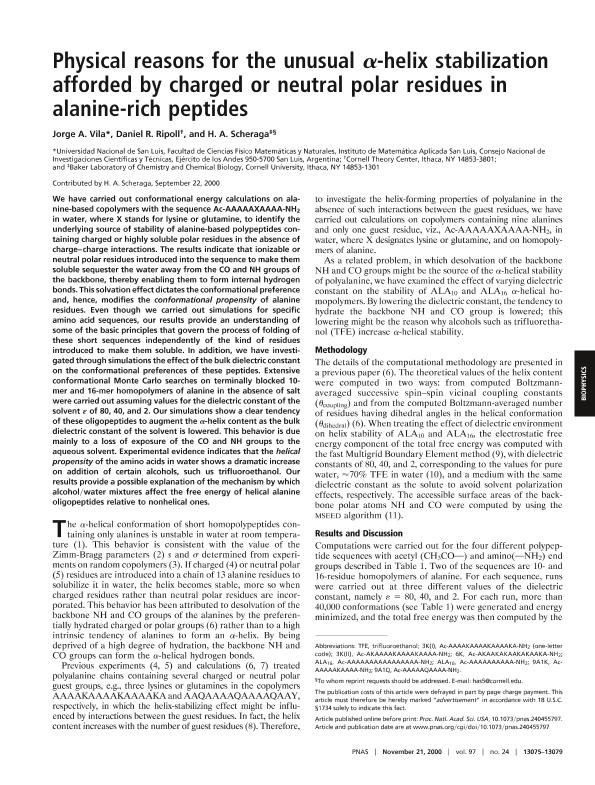Artículo
Physical reasons for the unusual α-helix stabilization afforded by charged or neutral polar residues in alanine-rich peptides
Fecha de publicación:
11/2000
Editorial:
National Academy of Sciences
Revista:
Proceedings of the National Academy of Sciences of The United States of America
ISSN:
0027-8424
Idioma:
Inglés
Tipo de recurso:
Artículo publicado
Clasificación temática:
Resumen
We have carried out conformational energy calculations on alanine-based copolymers with the sequence Ac-AAAAAXAAAA-NH2 in water, where X stands for lysine or glutamine, to identify the underlying source of stability of alanine-based polypeptides containing charged or highly soluble polar residues in the absence of charge-charge interactions. The results indicate that ionizable or neutral polar residues introduced into the sequence to make them soluble sequester the water away from the CO and NH groups of the backbone, thereby enabling them to form internal hydrogen bonds. This solvation effect dictates the conformational preference and, hence, modifies the conformational propensity of alanine residues. Even though we carried out simulations for specific amino acid sequences, our results provide an understanding of some of the basic principles that govern the process of folding of these short sequences independently of the kind of residues introduced to make them soluble. In addition, we have investigated through simulations the effect of the bulk dielectric constant on the conformational preferences of these peptides. Extensive conformational Monte Carlo searches on terminally blocked 10-mer and 16-mer homopolymers of alanine in the absence of salt were carried out assuming values for the dielectric constant of the solvent ε of 80, 40, and 2. Our simulations show a clear tendency of these oligopeptides to augment the α-helix content as the bulk dielectric constant of the solvent is lowered. This behavior is due mainly to a loss of exposure of the CO and NH groups to the aqueous solvent. Experimental evidence indicates that the helical propensity of the amino acids in water shows a dramatic increase on addition of certain alcohols, such us trifluoroethanol. Our results provide a possible explanation of the mechanism by which alcohol/water mixtures affect the free energy of helical alanine oligopeptides relative to nonhelical ones.
Palabras clave:
HELIX
,
STABILIZATION
Archivos asociados
Licencia
Identificadores
Colecciones
Articulos(IMASL)
Articulos de INST. DE MATEMATICA APLICADA DE SAN LUIS
Articulos de INST. DE MATEMATICA APLICADA DE SAN LUIS
Citación
Vila, Jorge Alberto; Ripoll, Daniel R.; Scheraga, Harold A.; Physical reasons for the unusual α-helix stabilization afforded by charged or neutral polar residues in alanine-rich peptides; National Academy of Sciences; Proceedings of the National Academy of Sciences of The United States of America; 97; 24; 11-2000; 13075-13079
Compartir
Altmétricas




